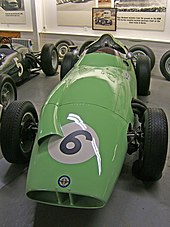British Racing Motors
A factory was set up in Spalding Road, Bourne, Lincolnshire, behind Eastgate House, Mays' family home, in a building called 'The Maltings' (the adjacent former ERA works, vacated in 1939).A string of failures caused much embarrassment, and the problems were still unsolved when the Commission Sportive Internationale announced in 1952 that for 1954, a new engine formula of 2.5 litres naturally aspirated or 750 cc supercharged would take effect.The P48 was revised for the 1.5 L rules in 1961, but once again BRM's own engine was not ready and the cars had to run with a Coventry-Climax four-cylinder unit in adapted P48 chassis, achieving very little in terms of results.The firm moved to a purpose-built workshop on an adjoining site in the spring of 1960, but when the 1.5-litre atmospheric Formula One regulation was introduced in 1961, Alfred Owen was threatening to pull the plug unless race victories were achieved very soon.He was given greater responsibility in 1960 after two of the drivers, Graham Hill and Dan Gurney, went on strike and told Alfred Owen they would not drive again, and in early 1962 full executive authority was given to Tony Rudd.A number of privateers acquired 1961 and 1962 BRMs during this period, including Maurice Trintignant and Scuderia Centro Sud; these cars continued to race for many years.While the engine was powerful, it was also heavy and unreliable - Rudd claimed that his drawings were not followed accurately and many of the castings were much thicker and heavier than he had specified (when Lotus took delivery of their first H16 it took six men to carry it from the van to the workshop).Spence's replacement, Richard Attwood, finished a good second to Graham Hill's Lotus at Monaco, but after this results went downhill and the season petered out ignominiously.Surtees' time at BRM was not a happy one and, despite the fact that a ground effect "wing car" was designed, this was never constructed and the team's performances were lacklustre.Surtees left after a single season (1969), along with Tony Rudd who went to Lotus (initially on the road-car side), and Geoff Johnson who departed for Austin Morris.Their last World Championship victory came when Jean-Pierre Beltoise drove a stunning race to win the rain-affected 1972 Monaco Grand Prix with the P160.The Owen Organisation ended its support of the team and it was run on a lower-key basis by Louis Stanley and some of the Bourne personnel as Stanley-BRM until 1977.The team became involved with Rover's gas-turbine project, with the Rover-BRM gas turbine car running at Le Mans in 1963 and 1965; it was damaged in testing and missed the 1964 race.The BRM-tuned version of the 1557 cc Lotus-Ford Twin Cam engine was particularly popular as the Special Equipment option on the Lotus Elan.BRM were contracted by Chrysler (UK) Competition Department to develop a sixteen-valve cylinder head for the Hillman Avenger engine.The Owen Organisation expected BRM to turn a profit through sales of racing engines; the four-cylinder appeared briefly in a Cooper-BRM special for Stirling Moss but found no other customers.Ironically this deal was also lost to McLaren for the 1974 season, to be replaced briefly by Motul in a pale green and silver colour scheme.A special edition Rover 200 was produced to commemorate the Rover-BRM gas-turbine car; this was finished in Brooklands Green (however not the very dark metallic gunmetal BRM shade) with an orange lower, front grill and silver details.The three 'new' P15 V16 BRMs have been made possible by the discovery of three unused chassis numbers which were originally allocated to the racing programme, but never built due to a change in the Formula 1 technical regulations at the time.









BRM (disambiguation)BourneLincolnshireEnglandRaymond MaysAlfred OwenLouis StanleyTony RuddJo BonnierTony BrooksRon FlockhartDan GurneyMike HawthornGraham HillNiki LaudaReg ParnellClay RegazzoniPedro RodríguezHarry SchellJo SiffertJackie StewartJohn SurteesMaurice TrintignantJean-Pierre BeltoiseFormula One1951 British Grand PrixClimaxConstructors'ChampionshipsDrivers'ChampionshipsRace victoriesPole positionsFastest laps1977 Italian Grand PrixSciroccoBrabhamMcLarenCooperConstructors' ChampionshipsDrivers' Championshipsmotor racinggrands prixSecond World Warhillclimbroad racingMercedes-BenzAuto Uniontrust fundRubery OwenHarry MundyFolkingham aerodromeBritish Racing Motors V161.5-litre supercharged V16Rolls-Roycecentrifugal superchargerswheelspinType 15Formula LibreGoodwoodCommission Sportive InternationaleFormula TwoAlfa RomeoFerrariLago-TalbotsO.S.C.A.Tony VandervellBritish Racing PartnershipBRM P25Stirling Moss1959 British Grand PrixType 25oversquareStewart TresilianMaserati 250FColin ChapmanCoventry-ClimaxRob WalkerDino V6Coventry Climaxmid-enginedWeslake EngineeringJohn CrosthwaiteScuderia Centro SudBRM P261first grand prix winTasmanBRM P83BRM P75flat-eightCosworthLotus 43Jim ClarkUS Grand PrixWatkins GlenLotus 42McLaren M5ALen TerryMike SpenceParnellground effectTony Southgate1970 Belgian Grand Prix1972 Monaco Grand Prix1972 World Championship Victory RaceMarlboro cigarettes1974 South African Grand PrixMike PilbeammonocoqueAurora AFX Formula One ChampionshipTeddy PiletteCan-AmRover-BRMgas turbineLe MansDonald CampbellBluebird-Proteus CN7Indianapolis 500Lotus-Ford Twin CamLotus ElanElan SprintEuropa JPSCaterham SevenHillman AvengerTasman SeriesTeam LotusJohn WyerBRM P153

